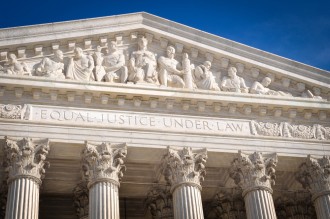
April 24, 2018
Inter Partes Review: If We’re Going to Have Them Then It’s All or Nothing
In SAS Institute Inc. v. Iancu, the Supreme Court held that the when the United States Patent and Trademark Office (USPTO) institutes Inter Partes Review, it must review all the grounds in the Petition and cannot choose to limit its review to only some of the grounds.
The opinion was written by Justice Gorsuch, who, if he had his druthers in Oils States (issued the same day), would have thrown out Inter Partes Review altogether.
SAS petitioned for review of ComplementSoft’s software patent, but the USPTO, relying upon 37 CFR §42.108(a) only instituted Inter Partes Review as to some of the challenged claims. SAS unsuccessfully argued before the Federal Circuit that 35 USC §318(a), required the Board to decide the patentability of every claim.
Justice Gorsuch found that 35 USC §318(a) “provides a ready answer.” He points out that §318(a) directs that if an Inter Partes Review is instituted and not dismissed under this chapter, the Board “shall issue a final written decision with respect to the patentability of any patent claim challenged by the petitioner …” He said “[t]his directive is both mandatory and comprehensive.” After a brief analysis of the grammar, he concludes:
when §318(a) says the Board’s final written decision ‘shall’ resolve the patentability of ‘any patent claim challenged by the petitioner,’ it means the Board must address every claim the petitioner has challenged.
Judge Gorsuch said it would seem to be an easy case:
Where a statute’s language carries a plain meaning, the duty of an administrative agency is to follow its commands as written, not to supplant those commands with others it may prefer.
The USPTO Director argued that while every claim instituted must be decided, not every claim has to be instituted. However, Justice Gorsuch dismissed this because “partial institution” power appears nowhere in the text of §318, or anywhere else in the statute, and what can be found in the statutory text and context strongly counsels against the Director’s argument.
Justice Gorsuch examined the statutory scheme for Inter Partes Review, noting that it is a petitioner-driven process, not a USPTO driven process. Moreover, while the Director is given discretion whether to institute, nothing suggests the Director enjoys a license to depart from the petition and institute a different Inter Partes Review of his own design. While §314 gives the Director discretion to institute if there is a reasonable likelihood the petitioner will prevail on at least one of the claims challenged in the petition, Judge Gorsuch explained that, rather than contemplate claim-by-claim institution, this language anticipates a regime where a reasonable prospect of success on a single claim justifies review of all.
Justice Gorsuch also pointed that that §318’s requirement that the Final Written Decision address “any patent claim challenged by the petitioner.” and rejected that any grammatical discrepancy between §314’s reference to claims found in the petition, and §318’s reference to claims challenged by the petitioner, makes any difference.
Justice Gorsuch also rejected the Director’s argument for efficiency, finding each side offers plausible reasons why its approach might make for the more efficient policy, but ultimately pointing out that policy arguments are properly addressed to Congress, not the Supreme Court.
Justice Gorsuch also rejected the Director’s argument for Chevron deference, which if still valid, only applies where the Court is unable to discern’s the Congress’ meaning. Justice Gorsuch had no uncertainty about the statutes’ “unmistakable commands.”
The final issue raised by the Director was whether partial institution was even reviewable, given the unappealability of institution decisions. He pointed out that after Cuozzo, if a party believes the USPTO has engaged in “shenanigans” by exceeding its statutory bounds, judicial review remains available, consistent with the Administrative Procedure Act, which directs courts to set aside agency action “not in
accordance with law” or “in excess of statutory jurisdiction, authority, or limitations.” Justice Gorsuch said that was precisely the sort of question before the court.
Because everything in the statute before it confirmed that SAS is entitled to a final written decision addressing all of the claims it has challenged, and nothing suggested the Court lacks the power to do so, the Supreme Court reversed the judgment of the Federal Circuit, and remanded the case for further proceedings consistent with this opinion.
Overall a banner day for the Federal Circuit — its a rare day that they bat .500 at 1 First St NE.



































